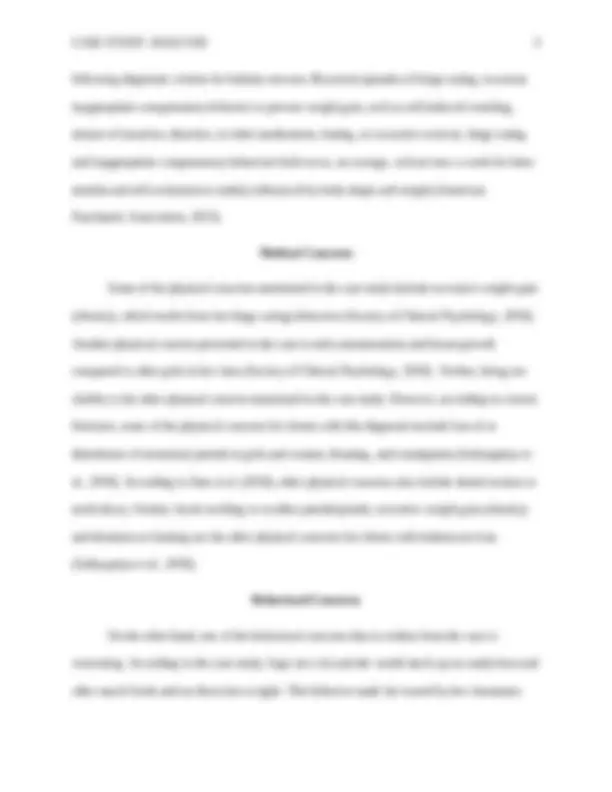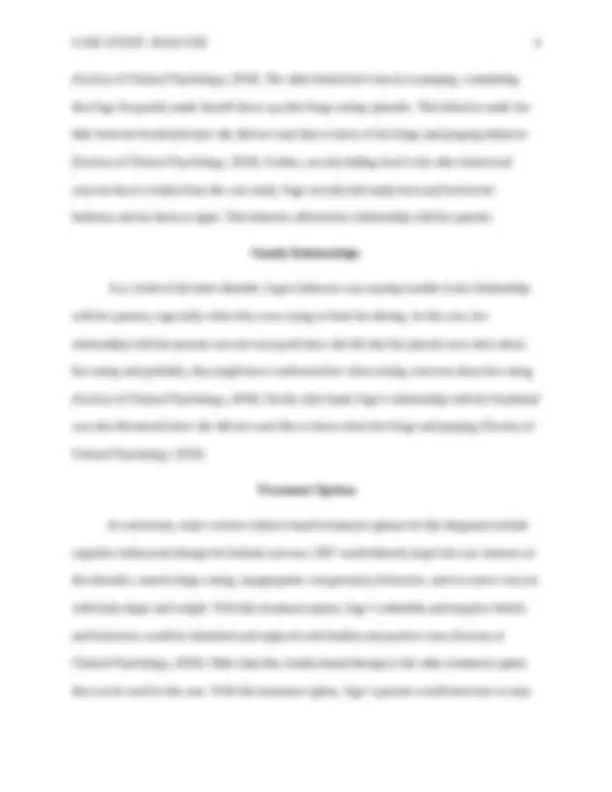





Study with the several resources on Docsity

Earn points by helping other students or get them with a premium plan


Prepare for your exams
Study with the several resources on Docsity

Earn points to download
Earn points by helping other students or get them with a premium plan
Community
Ask the community for help and clear up your study doubts
Discover the best universities in your country according to Docsity users
Free resources
Download our free guides on studying techniques, anxiety management strategies, and thesis advice from Docsity tutors
An in-depth analysis of a case study of a 26-year-old doctoral candidate named Sage, who was diagnosed with bulimia nervosa. Sage's symptoms, medical and physical concerns, behavioral issues, family relationships, and treatment options. The case study highlights the importance of understanding and treating bulimia nervosa due to its increasing prevalence.
What you will learn
Typology: Summaries
1 / 6

This page cannot be seen from the preview
Don't miss anything!




Case Study Analysis: Bulimia Nervosa Name Course Date
Case Study Analysis: Bulimia Nervosa According to literature by Zam et al. (2018), the number of eating disorders has significantly increased and these disroders are becoming more and more prevalent. While there are five classifications of eating disorders: anorexia, bulimia, binge eating disorder (BED), eating disorders, not other-wise specified (EDNOS) and night eating syndrome, over seven million girls and women and one million boys and men suffer from an eating disorder in their lifetime (Zam et al., 2018). This affirms why it is important for counselors to understand various eating disorders since they would effectively treat these increasingly growing disorders. However, from the given case studies, the "Case study: Sage (Bulimia Nervosa) from Division 12 of the American Psychological Association will be solely focused in this analysis. In this case study, Sage, a 26-year-old doctoral candidate in English literature at the local university, is diagnosed with bulimia nervosa (Society of Clinical Psychology, 2018). Symptoms of this Disorder Some of Sage's common symptoms that confirm her diagnosis included binges and purging (Society of Clinical Psychology, 2018). The case study mentions that she would stock up on candy bars and other snack foods and eat them, often in her bedroom late at night and had a vicious cycle of late-night binges after which she could sometimes make herself throw up. The other symptom was body image, since Sage felt “chubby, too big, and just wanting to be small (Society of Clinical Psychology, 2018). Further emotional dysregulation was her other symptom, where she hid food if she felt sad, scared, or mad and later ate them to feel better. Other than this, disordered eating was her other symptom since she has a habit of eating late at night (Society of Clinical Psychology, 2018). These symptoms were however similar to those of bulimia nervosa in the DSM-5. The Diagnostic and Statistical Manual of Mental Disorders (DSM-5) includes the
(Society of Clinical Psychology, 2018). The other behavioral concern is purging, considering that Sage frequently made herself throw up after binge eating episodes. This behavior made her hide from her boyfriend since she did not want him to know of her binge and purging behavior (Society of Clinical Psychology, 2018). Further, secretly hiding food is the other behavioral concern that is evident from the case study. Sage secretly hid candy bars and food in her bedroom and ate them at night. This behavior affected her relationship with her parents. Family Relationships As a result of the latter disorder, Sage's behavior was causing trouble in her relationship with her parents, especially when they were trying to limit her dieting. In this case, her relationship with her parents was not very good since she felt that her parents were strict about her eating and probably, they might have confronted her when raising concerns about her eating (Society of Clinical Psychology, 2018). On the other hand, Sage's relationship with her boyfriend was also threatened since she did not want him to know about her binge and purging (Society of Clinical Psychology, 2018). Treatment Options In conclusion, some current evidence-based treatment options for this diagnosis include cognitive behavioral therapy for bulimia nervosa. CBT would directly target the core features of this disorder, namely binge eating, inappropriate compensatory behaviors, and excessive concern with body shape and weight. With this treatment option, Sage’s unhealthy and negative beliefs and behaviors would be identified and replaced with healthy and positive ones (Society of Clinical Psychology, 2018). Other than this, family-based therapy is the other treatment option that can be used in this case. With this treatment option, Sage’s parents would intervene to stop
her unhealthy eating behaviors, help her regain control over her eating and help the family deal with problems that bulimia can have on Sage’s development and the family (Sathyapriya et al., 2018). Other than this, interpersonal psychotherapy is the other treatment option that can be used in the case. This option would help Sage address difficulties in her close relationships, helping her to improve her communication and problem-solving skills (Sathyapriya et al., 2018). Lastly, the Society of Clinical Psychology (2018) also mentions a healthy-weight program for bulimia nervosa as the other treatment option that can be used. This treatment option would help Sage in her weight loss journey.